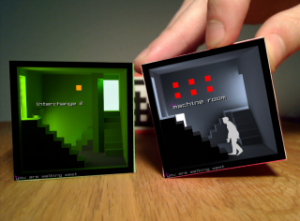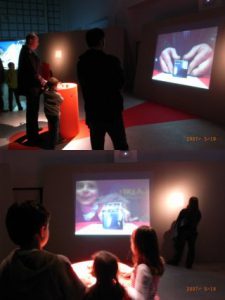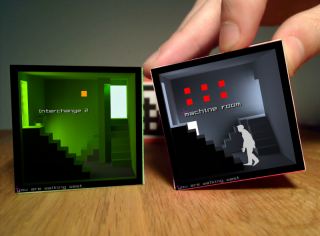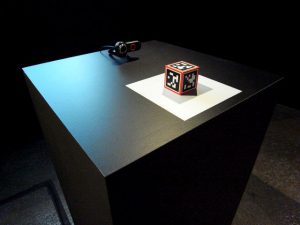levelHead is a spatial memory game by Julian Oliver.
levelHead uses a hand-held solid-plastic cube as its only interface. On-screen, it appears each face of the cube contains a little room, each of which are logically connected by doors.
The visual output is captured via a camera, and later overlaid onto the printed, checked. After which, the entire image (background and computerised overlaid graphics) and then projected onto a different, larger screen.

In one of these rooms is a character. By tilting the cube the player directs this character from room to room in an effort to find the exit.
Some doors lead nowhere and will send the character back to the room they started in, a trick designed to challenge the player’s spatial memory. Which doors belong to which rooms?
There are three cubes (levels) in total, each of which are connected by a single door. Players have the goal of moving the character from room to room, cube to cube in an attempt to find the final exit door of all three cubes. If this door is found the character will appear to leave the cube, walk across the table surface and vanish.. The game then begins again.
Source

It is a very interesting idea, that a simple object can be transformed into a device, without the object itself having any technical aspect. Rather, the object, or in this case the device, acts more of a medium on which a screen-based projection is overlaid on. The blend between the physical object and the projection here is seamless, and feels intuitive enough for the user. Personally, it is a very clever and simple idea.
From the documentation video, I noticed that the projections were a little too small for the eye to look at, but in subsequent installations, a larger screen was used to circumvent this limitation. In addition, I found the concept of this art to be very relevant to the medium – the physical space of imaginary and unseen architecture (through a digital world), realised through physical muscle memory and brain memory, reflects how modern day memory formation is created, through artificial computerised means, yet still reliant on ‘traditional’ techniques.
Creation Process
It consists of:
– 5 x 5 x 5 cubes, unique image (marker) on each face
– Computer with LinuxOS
– Sony EyeToy Camera
– Clean White Surface
Softwares used:
Vim
Blender
osgART
OpenSceneGraph
ARToolKit
ARToolKitPlus
osgCal

